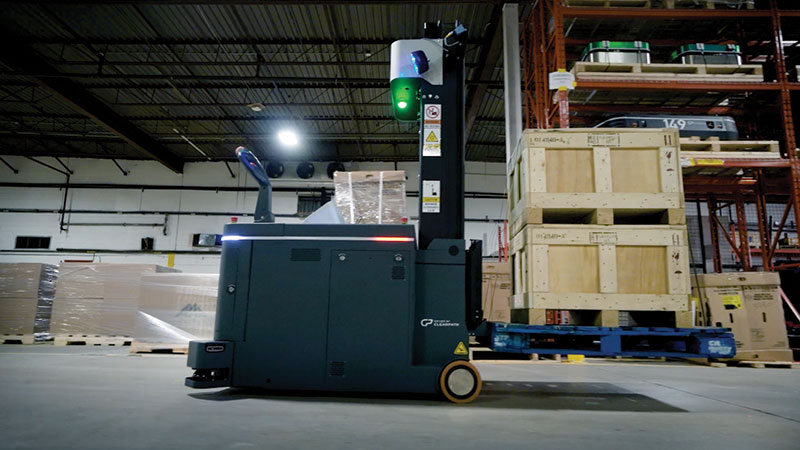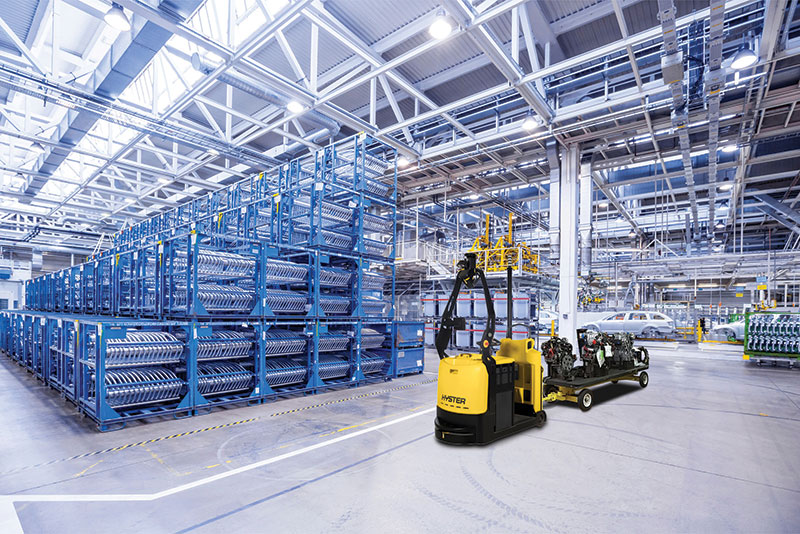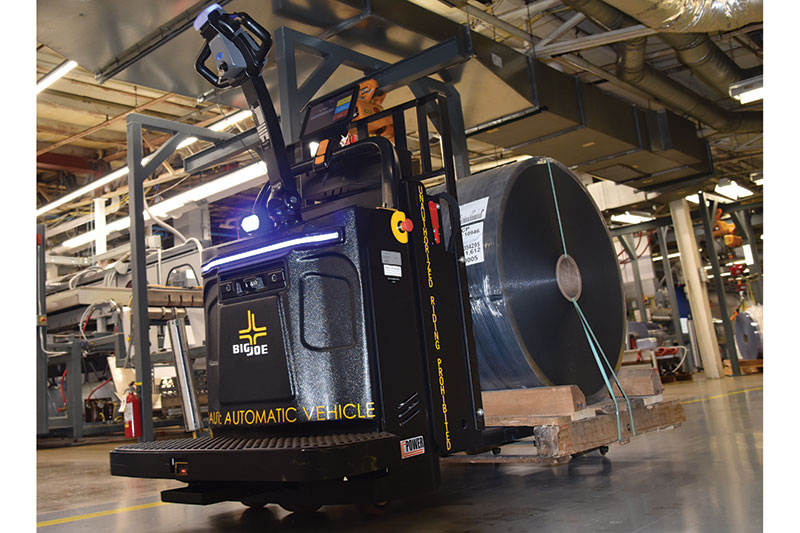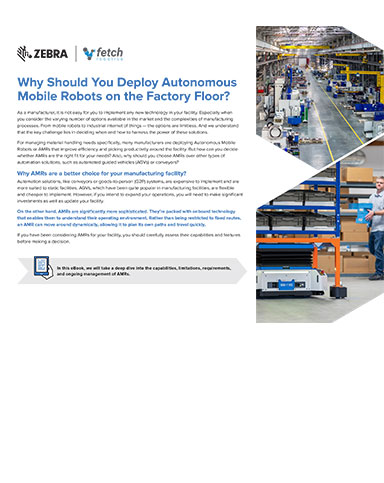Autonomous lift trucks emerge
From labor shortages to demand for ever-improved operational flexibility, this typically ignored class of trucks offers a chance to rethink your processes and even how you approach materials handling.
Hate to ask you to do this. But (please) put your phone down. Maybe even turn it off. It’s time for a talk we’ve avoided having for some time. And it can’t be put off any longer.
And, yes, it’s about autonomous lift trucks.
In all likelihood, you haven’t given them much thought. Lately or at all. And two years ago, that would have been fairly typical. That was even the case last year.
So, you are not alone. But if you continue to ignore autonomous lift trucks, you stand a chance of being really alone, if you get the drift here.
(Editors’ note: Despite the temptation to create a new acronym for autonomous lift trucks, we’re going to spare you that. It’s just too much for right now.)
Acronym aside, we’re now at a point where there’s too much risk to simply avoid evaluation of autonomous lift trucks any longer. The stack of reasons to consider them just keeps getting taller and taller when compared to traditional operator-driven trucks.
“To begin, automation inside the four walls of a facility is a steadily increasing reality,” says Bill Pedriana, chief marketing officer at Big Joe.

Come to think of it – why should lift trucks be any different than storage systems or packaging lines or horizontal product movers from conveyors to autonomous mobile robots?
Or as John Hayes, director of sales for North America over at BALYO, says, “there’s a lot less hidden magic in automation these days. People know it works and accept the value of automation to the functionality and efficiency of their operations without much if any discussion.”
And much of that drive to automation are limitations of the labor force, which is unlikely to reverse itself. And in that world, no one is buying an autonomous lift truck for the cool factor. It’s closer to self-preservation.
So rather than buying an autonomous lift truck per se, says Pedriana, you’re actually buying a lift truck with the capability to move goods unrestrained by labor availability.
The list of reasons for autonomous lift trucks is longer than that, explains Jay Judkowitz, vice president of product at OTTO Motors, a division of ClearPath Robotics. “These vehicles allow you to rethink your process not just from a labor standpoint, but for safety concerns, product line variabilities and waste.”
It’s important to note that the move to autonomous lift trucks, says Jim Gaskell, Crown’s director of automation and emerging technologies, is more than just a matter of automating what has always been a manual task. It’s critical to look at the entire work process and flow being affected by the switch over to automation.
In fact, at the ProMat show earlier this year, Judkowitz says the top question he was asked was how to best integrate autonomous lift trucks with current operations. He, and others, say it takes a plan and a long-term horizon, maybe as much as five or more years.
There’s a lot going on here, so let’s dig in a little more.
Where autonomous trucks fit
“Autonomous trucks are focused on large, heavy, bulky loads,” explains Martin Buena-Franco, Raymond’s lead for product marketing of automation.
Some are focused on moving pallet loads as large as 4,500 pounds and stackers with 3,000-pound capacity while others are tow tractors with a total load capacity of 15,000 pounds, says Kyle Smart, robotics sales manager at Hyster.

Autonomous lift trucks use LiDAR and SLAM technologies as well as sensors to map a facility initially and then navigate it entirely on their own. Typically, the autonomous truck receives task directions from the warehouse management system or even a warehouse execution system.
Both LiDAR (light detection and ranging) and SLAM (simultaneous localization and mapping) technologies allow the truck to make its own decisions about the best path to follow to complete each task without hitting fixed obstacles or pedestrians. On-board sensors and cameras provide real-time input for the navigation technologies.
Safety of people in the facility is a recurring story across suppliers. Quite simply, any advantage gained by removing an operator from the truck is completely negated without a high safety threshold for people elsewhere in the facility. The success of autonomous trucks ultimately is their ability to work side-by-side with people without gates, guards or fencing.
That brings us to an interesting question: Why bother with an autonomous truck when existing options include automatic guided vehicles (AGVs), automated lift trucks, autonomous mobile robots (AMRs) and, for that matter, conveyors? Isn’t this just a variation on themes that already exist? Not really.
Buena-Franco and Smart already set the stage by identifying the sweet spot for autonomous trucks. But there are other valuable distinctions to make along the way.
Let’s start with AGVs. Yes, they can carry large loads and even act as tuggers. However, an AGV’s path is generally fixed, a notable limitation in facilities that increasingly demand operational flexibility.
While that’s beginning to change as autonomous capabilities are on the rise with AGVs, autonomous trucks have far greater navigation flexibility right now. Furthermore, they offer traditional lift truck handling capability including the ability to lift loads to storage locations 200 inches and higher.

Similarly, an automated lift truck is one that follows either a wire or rail for at least part of its routing. This is especially common with narrow aisle and very narrow aisle trucks. Typically, an operator is on board who sets the speed but doesn’t steer while in automation mode, and both sets speed and provides manual steering when the truck is not following a set path in automation mode.
AMRs have the navigation flexibility of autonomous trucks, sharing LiDAR and SLAM features. However, AMRs are small, low-to-the ground vehicles that are quite limited in load size and load weight that they can easily move. Lifting capabilities are essentially non-existent. AMRs are really just for horizontal movement of goods.
As to conveyors, they are inflexible, fixed-position automation that actually limits traffic patterns of lift trucks, AGVs and AMRs in a facility. In fact, it’s exactly that profile of conveyors that opens the door to autonomous trucks able to adapt on the fly to changes in operations and products handled.
Making some decisions
Typically, Gaskell says, 1.5 autonomous lift trucks are required for every manual truck replaced. And typically, the autonomous ones move slower and take longer to position and transition loads.
That said, autonomous lift trucks have the potential for round-the-clock operation. That makes up for some of the limitations just mentioned, adds Gaskell. Furthermore, the most recent models offer more efficiency and speed than before, he continues. And compared to standard lift trucks, lift/lower speeds for autonomous models can be as much as twice.
“The ultimate goal,” says Gaskell, “is to produce autonomous trucks with increased speed and throughput that allows operations to move more pallets with fewer vehicles.”
It’s important to note that autonomous lift trucks can be both more and less autonomous. In other words, some operate entirely on their own while others feature what’s called operator assist.
At the ProMat show, Big Joe introduced its Pallet Mover AMR, a rider pallet truck, with operator assist. Pedriana says it uses “an intuitive tablet interface, LiDAR and camera system to transport and drop pallets to locations autonomously once the operator loads the truck and selects the mission.”
Pedriana says the truck can be set up and become operational in an hour, calling it a “force multiplier” by freeing up workers for more productive tasks than driving the truck.
Another variation on the autonomous trucks are the DualMode trucks from Crown, says Gaskell. Crown offers both a single-reach truck and a tow tractor that can be operated in either manual or autonomous mode at the flip of a switch. Trained operators can operate the intuitive interface on the truck to return to autonomous mode once manual maneuvers are completed.
Meanwhile, Raymond has built out its line of Courier autonomous trucks including a pallet truck, tow tractor and stacker, explains Buena-Franco. These vehicles use vision-guided technology to allow on-board navigation capabilities.
Similarly, BALYO has rounded out its line of autonomous trucks with an introduction earlier this year of a pallet truck with 4,000-pound capacity, explains Hayes. This model adds to the company’s autonomous line of 3,000-pound pallet trucks as well as tuggers and stackers.
Hyster’s entries here are a tow tractor and stacker, says Smart. The former is suited to long, repetitive tasks from parts sequencing to garbage hauls, maximizing the value of removing an operator from the operation. “With the stacker, automation of tasks such as moving pallets from conveyor lines over long distances to storage also benefits productivity by freeing the operator for other tasks,” says Smart.
And last year, Judkowitz says OTTO Motors released its OTTO Lifter. The truck lifts loads of 3,000 pounds to heights of 65 inches. It features what is called an intelligent pallet detection system for ease of handling skewed, off-center pallets.
Clearly, quite a bit has changed in the past couple of years. Advances range from the trucks themselves to a confluence of factors that make the autonomous equation a contender for moving large loads.
But perhaps most importantly, says Pedriana of Big Joe, autonomous lift trucks offer operations managers a chance to rethink how they approach materials handling.













